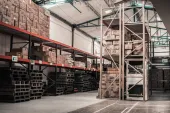
Sydney gross industrial takeup recovers for the first time since Q1 2022
Gross takeup reached over 300,000sqm in Q2.
Gross take-up in Sydney’s industrial property sector returned to elevated levels for the first time since the first quarter of 2022, totalling 311,600 sqm. According to JLL, total take-up increased by 170% relative to Q1 2023 and was 38% above the 10-year quarterly average (225,690 sqm).
Here’s more from JLL:
Demand was led by the Transport, Postal & Warehousing sector accounting for 48% of gross take-up (150,630 sqm), followed closely by the Manufacturing sector, comprising 25% (78,790 sqm) of total take-up.
Strong pipeline persists despite low completions
Four projects reached practical completion in the quarter, totalling 63,600 sqm, a level (53%) below the 10-year quarterly average (136,400 sqm). Despite supply chain disruptions easing, new stock delivery continues to be restricted by high construction costs and increasingly limited land availability.
JLL is currently tracking approximately 997,100 sqm of stock under construction in the Sydney industrial market, 30% of which has been pre-committed to. Over the next six months, about 532,300 sqm of new stock is due to come to market, of which 46% is currently pre-committed. New stock delivery over the next six months will be heavily weighted towards the Outer Central West precinct.
Robust rental growth remains amid low vacancy
Subdued speculative stock delivery and increasingly tight availability continued to place upward pressure on rental rates. Prime rents grew across all tracked precincts in the quarter, except the North, with South Sydney experiencing the most substantial growth at 12.4% q-o-q. Secondary rental growth matched the prime market across Sydney, with South Sydney exhibiting growth of 12.7% q-o-q.
Transaction volumes fell by 51% in the quarter, although they remained above the 10-year quarterly average (AUD 340.3 million) by 27.6%, totalling AUD 434.4 million. Investment sales accounted for 42% of transaction volumes, followed closely by new development sites (40%), while owner-occupiers comprised the remaining 18%.
Outlook: Robust rental growth is likely for the remainder of 2023
Demand from occupiers for space remains strong, although high gross occupancy costs may result in some occupiers relocating or subleasing a degree of space. Easing supply chain delays, tempering construction costs and existing structural tailwinds, are likely to support confidence and strong new stock delivery in the Sydney industrial market.
Rental growth is expected to remain strong over the remainder of the year before beginning to moderate in 2024. A degree of further yield softening is expected amid continued rental growth in a high bond rate environment.
Note: Sydney Logistics & Industrial refers to Sydney's industrial market (all grades).



















 Advertise
Advertise




